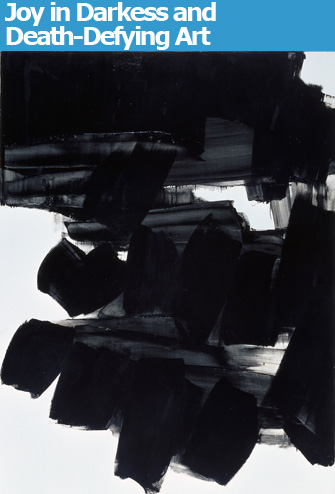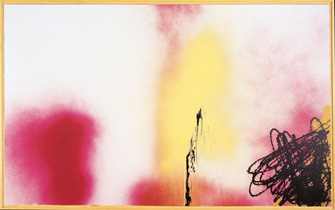
A painter whose work consists of abstract canvasses primarily covered in black makes an easy target for modern art skeptics of the “my-six-year-old-could-do-it” school, but that attitude would be very wrong in the case of Pierre Soulages, the subject of a just-opened retrospective at Paris’s Centre Pompidou (through March 8).
The one hundred or so works on show are almost without exception very beautiful and even moving. It is simply amazing what Soulages can do with black, although in reality he often integrates touches of color – gray, white, reddish or yellowish brown, near-Yves-Klein blue – into his pictures. Over the years, he has experimented with every possible permutation of black, with surprisingly little repetition in the 60 years’ worth of work on show.
Soulages is always playing with color, intensity, texture, lines and forms. Some canvases are painted with walnut stain, which is responsible for that particular reddish-brown color mentioned above, or tar, which creates the yellowish-brown tones. Some consist entirely of thick black impastos in various patterns. Some have matte surfaces, others glossy. Some are painted on cracked sheets or fragments of glass. Some are calligraphic and meditative, while others are very solid and materialistic, and still others are highly sensual in their lavish use of black paint.
The most beautiful paintings are usually the simplest, with often-sensational results – in his painting of March 19, 2006 (all his paintings are titled with their dimensions and the date they were completed), for example, the fine, irregular strips of yellowish-beige showing through the black paint have an effect as breathtaking as the onset of sunrise on the horizon.
What Soulages is interested in is how light reacts with the black paint, and his many experiments show in how many ways this can happen. He describes the “secret light” radiated by black, which is “all the more powerful because it is coming from the greatest absence of light.”
Black may be the color of death in Western iconography, but in Soulages’ hands it becomes pure joy.

Meanwhile, another inspiring exhibition, “Deadline” (through January 10), at the Musée d’Art Moderne de la Ville de Paris, actually does deal with death. The curators have had the interesting idea of looking at the last works of 13 artists who died within the past 20 years. Most of them either knew they were dying or were ill or disabled when they created these pieces.
Thankfully, the museum draws no conclusions from the works of this disparate group of artists – among them painters, photographers, sculptors, and installation and performance artists – but simply presents some of the last works of each in separate spaces, with no commentary – just a short description of the situation each one was in vis-à-vis his or her coming death. The only thing this group of artists has in common is that they all kept working with a vengeance.
Some were well-aware of their impending end, including Robert Mapplethorpe (1946-89), Felix Gonzalez-Torres (1957-96) and Israeli artist Absalon (1964-93), all of whom had AIDS. Absalon is represented not only in videos in which he acts out his angst by screaming or fist-fighting with the air, but also by a tiny, cramped, white-painted “cell” (with spaces for all the necessities found in an apartment, including a kitchen, bathroom and bed). Visitors are allowed to enter this minimalist “home,” only to feel the world closing in around them claustrophobically.
Few took on the subject of death as directly as Martin Kippenberger (1953-97), who painted his own versions of Théodore Géricault’s famed “The Raft of the Medusa” (it would have been helpful if the curators had provided a reproduction of the painting or even borrowed it from the Louvre as a reference), which depicts the dead and dying on a raft after a shipwreck. Kippenberger paints himself as a desperate man reaching out for help and even as a cadaver in these Baconesque paintings in lurid colors.
Mapplethorpe was rather literal in photos of himself posing with a skull, but his black-and-white images of ancient statues in smooth white marble, looking like frozen people, are lovely.
Other artists were physically limited by illnesses toward the end of their lives. Hans Hartung painted his last, very beautiful “action” paintings with a vine-spraying machine and relied on help from his assistants to make them. Joan Mitchell (1925-92), who had limited mobility in her arms, continued to paint on large canvases, but the results are understandably sketchier and less powerful than her earlier works. Willem de Kooning (1904-97), who suffered from memory loss (probably caused by Alzheimer’s disease) in the 1980s, nevertheless remained “alert and engaged” when painting. His last abstract works, far less complex than those that came before, have been the subject of great debate in the art world as to their artistic value, but the tide now seems to be turning toward an appreciation of them. Seen on their own here (it would have been nice to have a few earlier ones for comparison’s sake) they seem almost like cartoon abstract paintings, all twisting lines that are impressive for their use of color.
Hannah Villiger (1951-97), the only other woman in the show, was diagnosed with tuberculosis in 1980 and grew increasingly frail over the years. She is represented by large-scale color photographs, which seem abstract at first glance, of details of blood-red fabric, with glimpses of her emaciated body showing through here and there.
This exhibition brings to mind Henri Matisse, who, when forced to stop painting by illness, started making his wonderful paper cutouts. For artists, it seems, life can go on even in the face of death.
Centre Pompidou: 19, rue Beaubourg, 75004 Paris. Tel.: 01 44 78 12 33. Open 11 a.m.-9 p.m. Closed Tuesday. Métro: Rambuteau. Admission: €10-€12. Through March 8. www.centrepompidou.fr
Musée d’Art Moderne de la Ville de Paris: 11, avenue du Président Wilson, 75116 Paris. Métro: Alma-Marceau or Iéna. Tel.: 01 53 67 40 00. Open Tuesday-Sunday, 10 a.m.-6 p.m. (Thursday until 10 p.m.). Closed on Mondays and public holidays. Admission: €9. Through January 10. www.mam.paris.fr
© 2009 Paris Update
Favorite